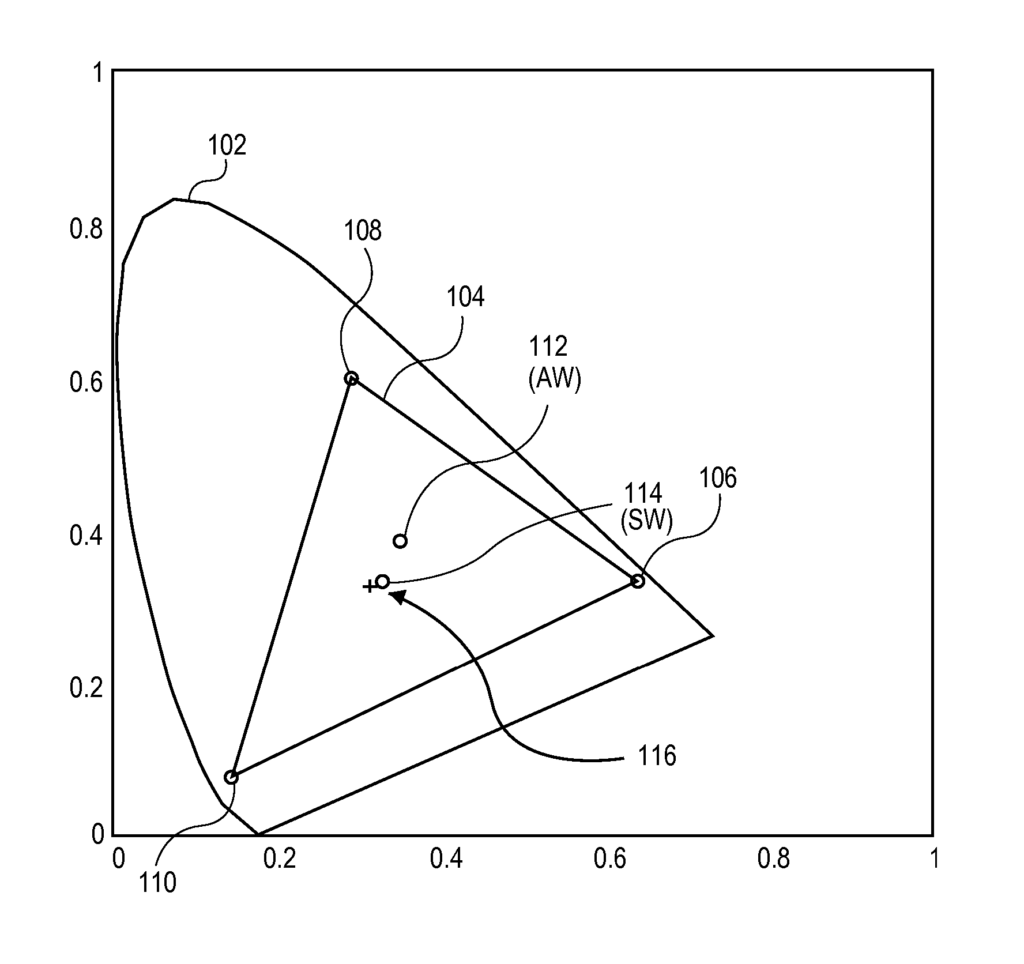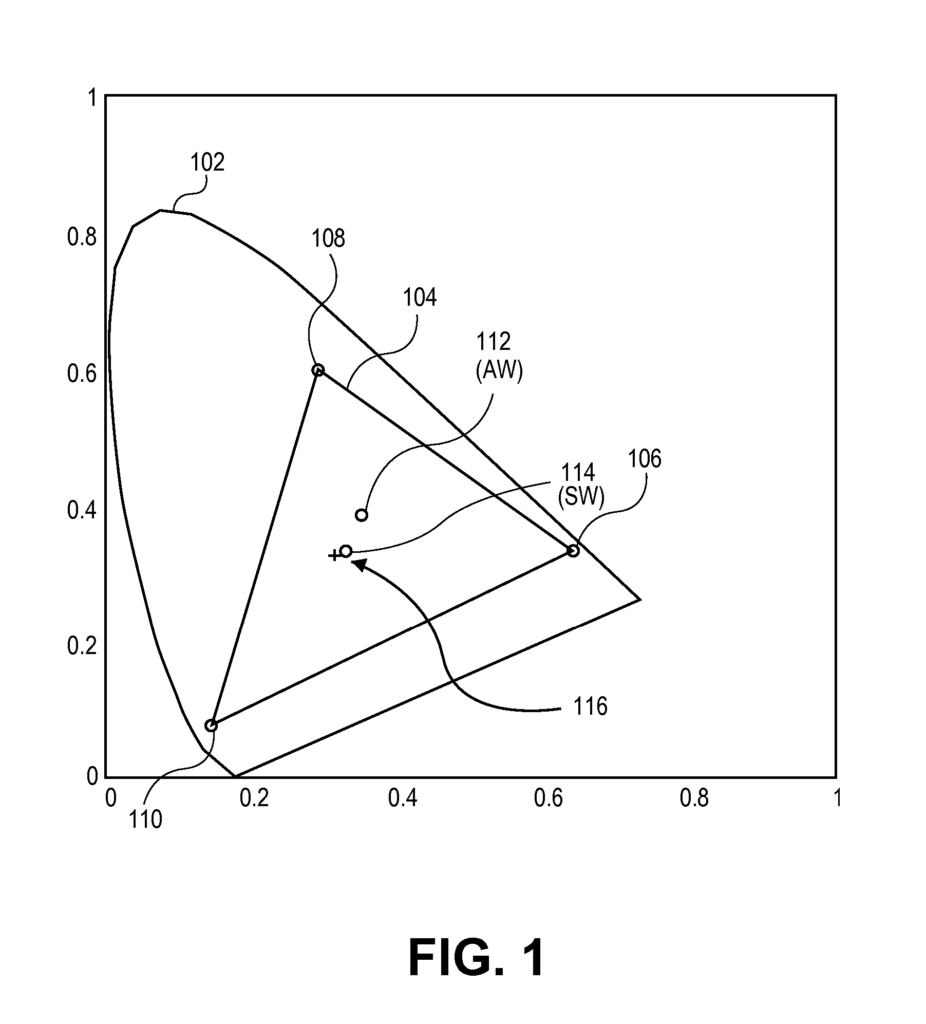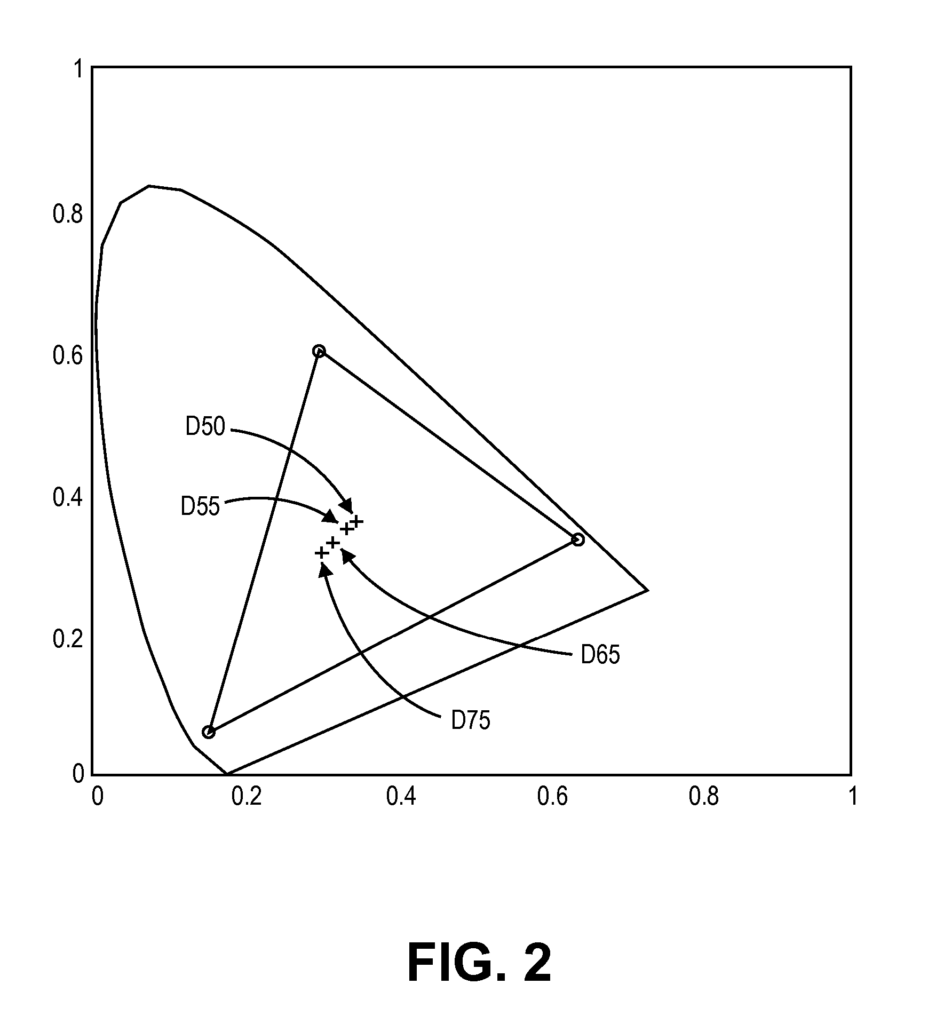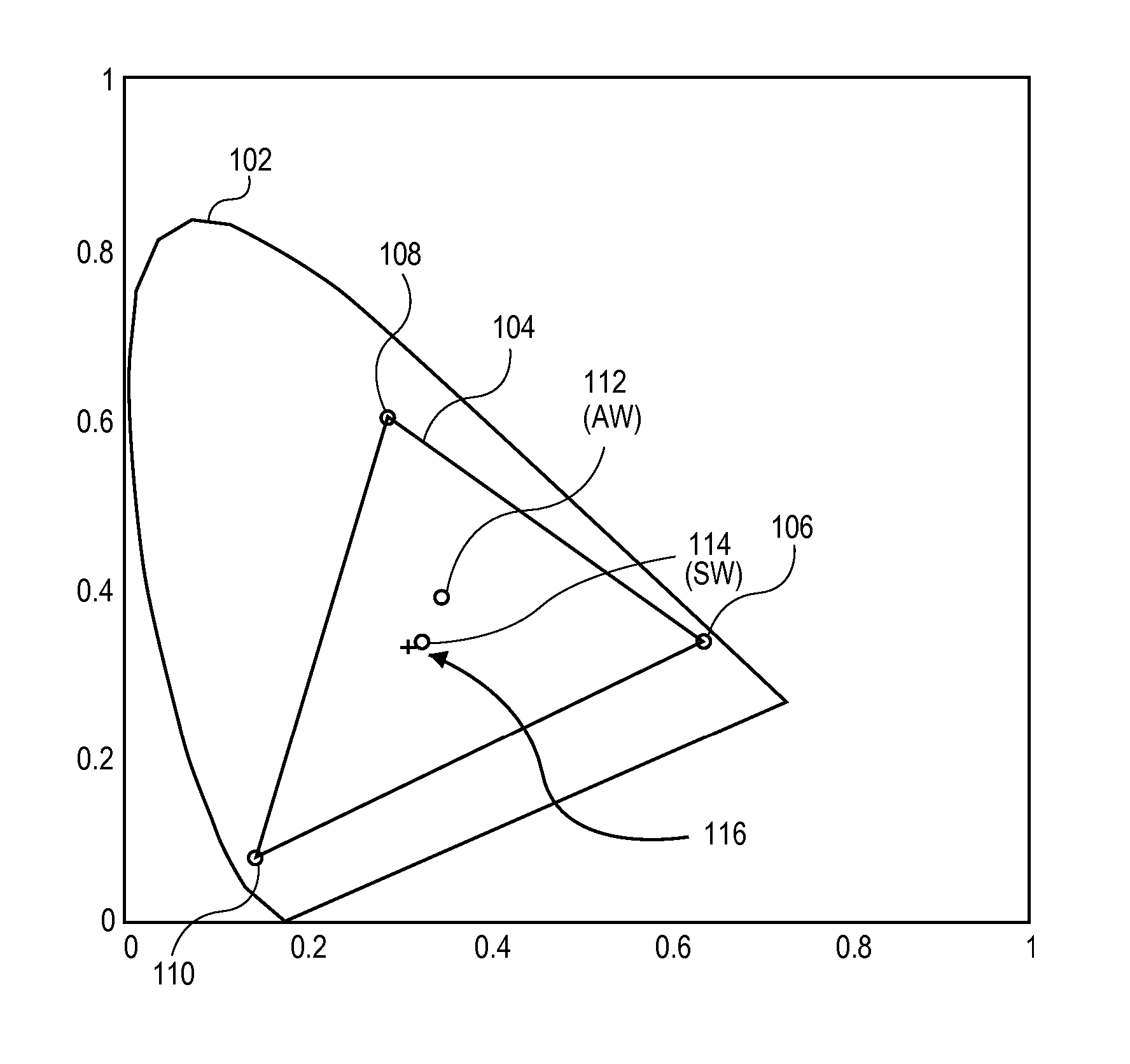Invented by Michael Francis Higgins, Candice Hellen Brown Elliott, Samsung Display Co Ltd
In the world of image displays, the white point refers to the color temperature of white displayed on a screen. It plays a crucial role in determining the overall color accuracy and visual experience of an image. Selecting the right white point is essential for various industries, including photography, graphic design, video editing, and even medical imaging.
One of the key factors driving the market growth is the increasing demand for color-accurate displays. With the rise of digital content creation and consumption, professionals and consumers alike are seeking displays that can reproduce colors as accurately as possible. This has led to the development of systems and methods that allow users to calibrate and adjust the white point of their displays to match their specific requirements.
Another factor contributing to the market growth is the advancements in display technology. With the introduction of high-resolution displays, OLED panels, and HDR (High Dynamic Range) technology, the need for precise white point selection has become even more critical. These advanced displays offer a wider color gamut and improved contrast, making it essential to calibrate the white point accurately to achieve optimal color reproduction.
Furthermore, the increasing adoption of mobile devices and tablets has also fueled the demand for systems and methods for selecting a white point. As more people rely on these devices for various tasks, including content creation and consumption, there is a growing need for accurate color representation on smaller screens. This has led to the development of mobile-friendly solutions that allow users to calibrate the white point of their devices on the go.
The market for systems and methods for selecting a white point is highly competitive, with several key players offering innovative solutions. These solutions range from software-based calibration tools to hardware devices that measure and adjust the white point accurately. Some companies also offer integrated solutions that combine hardware and software to provide a comprehensive white point selection experience.
In addition to the professional market, there is also a growing demand for consumer-oriented solutions. With the increasing popularity of home entertainment systems and gaming consoles, consumers are seeking displays that can deliver an immersive visual experience. This has led to the development of user-friendly solutions that allow consumers to calibrate the white point of their displays easily.
Overall, the market for systems and methods for selecting a white point for image displays is expected to continue growing in the coming years. As technology advances and the demand for accurate color representation increases, the need for innovative solutions will only become more significant. Whether it’s for professional use or personal enjoyment, selecting the right white point is crucial for achieving optimal color accuracy and visual experience on image displays.

The Samsung Display Co Ltd invention works as follows
The present application describes several embodiments that disclose systems, techniques and methods to change or render input image data, which may assume a white point in a display, into image data rendered at a second assumed, desired, or measured white point.

Background for Systems and Methods for Selecting a White Point for Image Displays
Patents and applications of the United States that are owned by a group include: No. 09/916,232 (?the ‘232 application? The ‘232 application? Filed Jul. Now issued as U.S. Pat. No. 6,903,754; (2) U.S. patent application Ser. No. 10/278,353 (?the ‘353 application? 10/278,353 (?the ‘353 application? Published as United States Patent Application Publication No. 2003/0128225; (3) U.S. patent application Ser. No. 10/278,352 (?the ‘352 application? 10/278,352 (?the ‘352 application? Published as United States Patent Application Publication No. 2003/0128179; (4) U.S. patent application Ser. No. No. 10/243.094 (the ‘094 Application), entitled?IMPROVED COLOR ARRANGEMENTS FOR SUB-PIXEL RENDERING? Filed Sep. 13,2002, and published under United States Patent Application Publication No. 2004/0051724; (5) U.S. patent application Ser. No. 10/278,328 (?the ‘328 application? 10/278,328 (?the ‘328 application? Published as United States Patent Application Publication No. 2003/0117423; (6) U.S. patent application Ser. No. 10/278,393 (?the ‘393 application? 10/278,393 (?the ‘393 application? Published as United States Patent Application Publication No. 2003/0090581 and (7) U.S. Patent Application Ser. No. 10/347,001 (?the ‘001 application?) The ‘001 application? Published as United States Patent Application Publication No. Novel sub-pixel arrangements for improving cost/performance curves of image display devices are disclosed in 2004/0080479 and each is hereby incorporated by referencing the entire document.
The following systems and techniques are disclosed to achieve proper dot inversion schemes for certain subpixel groups with an even number in a horizontal plane. These applications and patents have been incorporated herein by reference. No. No. 10/456 839, entitled “IMAGE DEGRADATION CORRECTION IN NOVEL CRYSTAL DELIVERIES” Published as United States Patent Application Publication No. 2004/0246280; (2) U.S. patent application Ser. No. No. 10/455925, entitled “DISPLAY PANEL WITH CROSSOVER CONNECTIONS AFFECTING DOT INVERSION?” Published as United States Patent Application Publication No. 2004/0246213; (3) U.S. patent application Ser. No. No. 10/455,931 entitled “SYSTEM AND METHOD FOR PERFORMING DOT INVERSION WITH STANDARD DRIVERS AND BACKPLANE OVER NOVEL DISPLAY PANELS LAYOUTS” And issued as U.S. Pat. No. 7,218,301; (4) U.S. patent application Ser. No. No. The U.S. Pat. No. 7,209,105; (5) U.S. patent application Ser. No. No. 10/456 806, entitled “DOT INVERSION OF NOVEL DISPLAY PANELS WITH EXTRA DRIVERS?” The U.S. Pat. No. Patent application No. 7,187,353 and (6) U.S. Ser. No. No. 10/456 838, entitled “LIQUID CRYSTAL DISPLAY BACKWARD PLANES AND ADDRESSING OF NON-STANDARD SUBPIXEL ARRANGEMENTS” Published as United States Patent Application Publication No. The publication number for the United States Patent Application Publication is 2004/0246404. No. The United States Patent Application Publication Number 10/696 236 entitled “IMAGE DEGRADATION CORRECTION IN NOVEL LIQUID CRYSTAL DISPLAYS W/SPLIT BLUE SUBPixels”, filed on Oct. 28, 2003 and published under the United States Patent Application Publication number 2005/0083277. 2005/0083277. (8) U.S. Patent application Ser. No. No. 23rd, 2004. Published as U.S. Pat. No. 7,268,758.
These improvements are especially pronounced when combined with the sub-pixel rendering systems and methods disclosed in these applications as well as in patents and United States patents owned by other parties: (1) U.S. No. 10/051,612 (?the ‘612 application? 10/051,612 (?the ‘612 application? Filed Jan. 16,2002, now U.S. Pat. No. 7,123,277; (2) U.S. patent application Ser. No. 10/150,355 (?the ‘355 application? 10/150,355 (?the ‘355 application? Filed May 17, 2002 and now issued under U.S. Pat. No. 7,221,381; (3) U.S. patent application Ser. No. 10/215,843 (?the ‘843 application? 10/215,843 (?the ‘843 application? Filed on Aug. 8,2002 and issued as U.S. Pat. No. 7,184,066; (4) U.S. patent application Ser. No. No. Filed on Mar. Published as United States Patent Application Publication No. 2004/0196302; (5) U.S. patent application Ser. No. No. 10/379.765, entitled “SYSTEMS AND MECHANISMS FOR MOTION ADAPTIVA FILTERING”, filed Mar. Filed Mar. Filed Mar. 4, 2003, and issued as U.S. Pat. No. 7,167,186; (6) U.S. patent application Ser. No. No. 10/379 766 entitled ‘SUB-PIXEL RENDERING SYSTEM and METHOD FOR IMPROVED DISPLAY VIEWING ANGLES’ Filed Mar. Filed Mar. 4, 2003, and issued as U.S. Pat. No. No. 6,917 368; (7) U.S. Patent application Ser. No. No. Filed Apr. Published as United States Patent Application Publication No. “2004/0196297 is hereby incorporated by reference herein in its entirety.
Patents and applications in the United States that are owned by or co-pending with each other disclose improvements in gamut conversion. No. No. 10/691 200 entitled “HUE ANGLE CALCULATING SYSTEMS AND METHODS”, filed on Oct. 21, 2003, and issued as U.S. Patent. No. 6,980,219; (2) U.S. patent application Ser. No. Published as United States Patent Application Publication Number. 2005/0083341; (3) U.S. patent application Ser. No. Published as United States Patent Application Publication Number. 2005/0083352 and (4) U.S. Patent Application Ser. No. No. Patent No. 10/690,716 entitled?GAMUT CONVERSION SYSTEM AND METHODS” No. No.
Patent application No. No. No. No. 7,084,923 (2) U.S. patent application Ser. No. No. 10/696.026 entitled ‘SYSTEM AND METHOD OF PERFORMING IMAGE RESCONSTRUCTION TO EFFECT SCALING IN MULTI MODE DISPLAY’ Filed Oct. 28, 2003, and published under United States Patent Application Publication No. All of these are hereby incorporated as references. “All patent applications mentioned within this specification will be incorporated in full by reference.
In addition, these coowned and copending applications are hereby incorporated herein by reference in full: (1) U.S. Patent application Ser. No. The United States Patent Application Publication Number is 2005/0225548. 2005/0225548; (2) U.S. patent application Ser. No. The United States Patent Application Publication Number. 2005/0225574; (3) U.S. patent application Ser. No. The United States Patent Application Publication Number 10/821 306 is entitled “SYSTEMS AND MEANS FOR IMPROVED GAMUTH MAPPING FROM A SET OF IMAGE DATA TO ANOTHER” and was published in the United States Patent Application Publication. 2005/0225562; (4) U.S. patent application Ser. No. No. No. All of which are hereby incorporated as references. “All patent applications referred to in this specification will be incorporated in full by reference.
Now, we will refer in detail to the implementations and embodiments that are shown in the accompanying drawings.” The same reference numbers are used to refer to similar or identical parts wherever possible.
The white point on an image display is not always a color that you want. It is possible to correct this by adjusting the color temperature, but it could be costly. Some monitors also have an option to change the white point so that all images appear ‘warmer’. The white point can be changed to make all images appear?warmer? The various embodiments of this invention are shown here. They show methods and systems for changing the white point into any desired color, without having to change the backlight. The techniques and embodiments of the present invention are applicable to all types of displays, including multi-primary, RGBW, and RGB primary displays. Multi-primary systems and RGBW systems use conversion matrices. Changing these matrices can change the white point on a display without the need to change the backlight.
The difference between the white point measured and desired of a display may introduce errors in the chromaticity triangular number calculation. It could result in incorrect conversions being applied to certain input colors. This error is corrected by the present invention, which will be described below.
The Correct White Point to Use:

There may be several white points to choose from in the case of a system with multiple primary pixels and a subpixel that is white. FIG. FIG. This envelope 102 contains all of the visible colors. This triangular region represents the typical monitor gamut, which encompasses all colors that could be displayed by a television, monitor or other image rendering devices. This region 104, which is triangular, assumes that an image display device uses three primary colors: red 106 and green 108 as well as blue 110, apart from the white subpixel.
The AW point (also called white point 112) is the result of all three colored primaries being on. The ‘AW? The?SW? point is the result of turning only on white subpixels. There may also be another “desired”? White point 116, e.g. D65). These three white points can be used in different ways depending on the intended use. As an example, it may be desirable to have a whitepoint because that is the whitepoint assumed for the image input data. This white point can be different than the measured white of the image display.
The following equation can be used to solve numerically for C weighting coefficients using RGBW.
The notation SW refers to the CIE xyz values of chroma for the SW sub-pixel measured in white. The notation AWX refers to the CIE tri-stimulus value for the AW white measured with all primaries fully on.
The equation 1 can be used to find the weighting coefficients for Cr Cg Cb, and Cw. These values may then be combined with primary chromaticity to create an equation that converts RGBW values into CIE tri-stimulus. If you have a system that has more than one primary, then there will be more “columns” in the equation. In the equation, there are more?columns? A display with a primary cyan would have chromaticity measurements xc, yc, and zc. There would be an extra weight coefficient, Cc, to solve. If there is no white subpixel in a multiprimary display, then the column with the xSW,ySW andzSW values would not exist and therefore, no Cw coefficient could be solved. Please note that the word ‘column’ is used loosely. The term?column’ is used here in a loose way. Equation 1 has only one column, but is derived by a matrix that had a column for each of the primary.
The weight coefficients in equation 1 can be used to create a matrix that converts RGBW (or any other multi-primary system) into CIE XYZ. The weight coefficients from equation 1 can be used to build a matrix for converting CIE values into RGBW or other multi-primary system. These matrices can be combined with conversion matrices, such as sRGB to CIE XYZ. It is then possible to convert the source data to any multi-primary systems with just a single matrix multiplier.
Equation 1 takes into account the SW chromaticity values of the sub-pixel white and the AW tristimulus measurements of the white point. It produces the mathematically accurate conversion but sometimes with unexpected results. If the input data has a sRGB color space, it will have the D65 assumption for the white point. If the white point of a primary display is not D65 then the sRGB value (255255255) won’t result in the multi-primary values of (255255255255). It is expected that the brightest input value will result in the most brightly colored output value. The brightest possible result may not always be the correct color. However, the?brightest possible? One solution is to replace D65 in equation 1 by AW. This results in the following equation.
The resulting matrixes will have the expected result when all multi-primary matrices recalculated using this starting point. The result of converting RGB (255.255.255) to multi-primary values is (255.255.255.255). This may be a good approximation if the measured AW is close to D65. If the backlight is changed until the measured AW White Point is D65, then equation 2 will be mathematically correct. result. This may require an additional backlight, which would increase the price of the display.
The equation 1 can be used as a base to create conversion matrices. One example would be to use the RGBW panel’s measured chromaticity in equation 1 when the input color is sRGB. (255,255.255). This could produce a RGBW color (176,186.451,451). It is not within the gamut. You can use gamut clamping and scaling to bring it into range. This step gives you (99,105255255). This panel is known to be a “warm” white point. If this panel was known to have a very?warm? The sRGB color closest to ‘full on? is the one that maps to the AW white point. By applying the gamut clamping and inverse conversion to the measured AW colour, the sRGB closest to ‘full on’ is (255,244,135). On this RGBW display, (255.244.135) was the closest sRGB color to?full on? The display’s white point is bright yellow, which was expected.
Click here to view the patent on Google Patents.

Leave a Reply